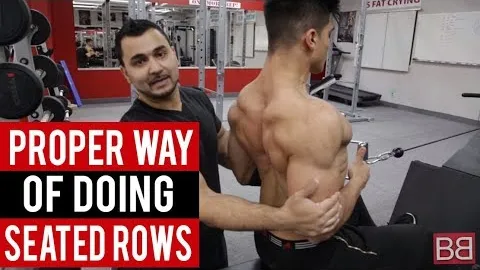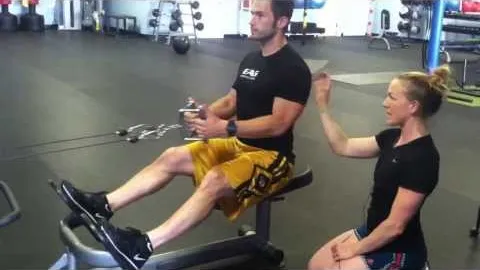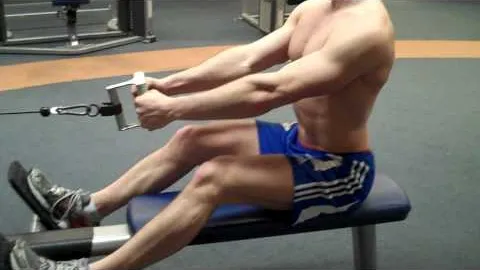




The Seated Row Exercise: Building Strong Back Muscles
Introduction
If you’re looking to strengthen your back muscles and improve your overall posture, then the seated row exercise is an excellent choice. This compound exercise targets multiple muscles in your upper body, including the latissimus dorsi, rhomboids, trapezius, and biceps. In this article, we will delve into the details of the seated row exercise and explore its benefits, proper form, variations, and common mistakes to avoid. So, let’s get started and unlock the secrets to a stronger, more defined back!
Benefits of Seated Row Exercise
Muscle Development: The seated row exercise primarily targets the major muscles in your back, such as the latissimus dorsi, which is responsible for the wide, V-shaped appearance of your upper body. Regularly incorporating seated rows into your workout routine can lead to increased muscle size and strength in these areas.
Improved Posture: Many people suffer from poor posture due to weak back muscles. The seated row exercise helps strengthen the muscles responsible for maintaining a healthy posture, namely the rhomboids and trapezius. By regularly engaging in this exercise, you can train these muscles to support your spine and promote proper alignment.
Increased Upper Body Strength: Seated rows engage not only your back muscles but also your biceps, forearms, and shoulders. This compound exercise provides a challenging workout for your upper body, helping to enhance overall strength and power.
Injury Prevention: Strengthening the muscles involved in the seated row exercise can help prevent injuries, particularly in the lower back. By building a strong back, you provide stability and support to your spine, reducing the risk of strains and sprains.
Proper Form
To maximize the benefits of the seated row exercise and minimize the risk of injury, it is crucial to maintain proper form. Here's a step-by-step guide on how to perform a seated row correctly:
Set-Up: Sit on the rowing machine with your feet securely placed on the footrests and your knees slightly bent. Grab the rowing handle with an overhand grip, ensuring your palms are facing downward. Lean forward slightly and keep your back straight.
Starting Position: Begin with your arms fully extended in front of you, ensuring that your shoulders are relaxed and your chest is slightly lifted.
Execution: Squeeze your shoulder blades together and pull the handle towards your body, maintaining a controlled movement. Aim to bring the handle towards your lower chest without excessively arching your back. Exhale during this phase of the movement.
Return: Slowly extend your arms back to the starting position, keeping tension in your back muscles throughout the entire exercise. Inhale as you return to the starting position.
Repetition: Repeat the exercise for the desired number of repetitions, typically 8-12 in a set.
Variations of Seated Row
To ensure continuous progress and prevent plateaus, it's important to periodically introduce variations to your workout routine. Here are a few modifications to the seated row exercise:
Dumbbell Seated Row: If you do not have access to a rowing machine, you can perform seated rows using dumbbells. Sit on a bench with your feet planted firmly on the ground and hold a dumbbell in each hand. Pull the dumbbells towards your lower chest, making sure to keep your back straight and engaged.
Resistance Band Seated Row: Another alternative to the rowing machine is using a resistance band. Attach the band to a sturdy anchor point and sit upright on the ground, gripping the band with both hands. Pull the band towards your body, focusing on squeezing your shoulder blades together.
Close Grip Seated Row: To target your inner back muscles and biceps to a greater extent, perform the seated row with a close grip. Bring your hands closer together on the rowing handle while maintaining the same form as the traditional seated row.
Common Mistakes to Avoid
To fully reap the benefits of the seated row exercise and prevent injury, it's crucial to avoid common mistakes. Here are a few errors to watch out for:
Using Excessive Weight: Using too much weight can compromise your form, leading to potential strains and injuries. Focus on maintaining proper technique and gradually increase the weight as your strength improves.
Rounding Your Back: It's important to keep your back straight and avoid any excessive rounding during the movement. Arching your back excessively can place unnecessary stress on your spine.
Neglecting Full Range of Motion: Ensure that you pull the handle towards your lower chest, allowing your shoulder blades to fully retract. Neglecting the full range of motion can limit the effectiveness of the exercise.
Using Momentum: Avoid using momentum to complete the movement. Instead, focus on a controlled and deliberate motion, utilizing your back muscles to perform the exercise.
Conclusion
The seated row exercise offers numerous benefits, ranging from improved posture and muscle development to enhanced upper body strength and injury prevention. By incorporating proper form, variations, and avoiding common mistakes, you can make the most of this compound exercise. So, whether you're a beginner or an experienced fitness enthusiast, don't overlook the power of the seated row exercise in building a strong and defined back. Start rowing your way to a healthier, more confident you today!
If you're looking for a gym, fitness club or yoga studio, you've come to the right place.
You can find information about gyms in your area. Browse catalog of gyms and find gyms with classes which are you looking for.
On gym page you can find simple information like address, phone or website. You can find list of available classes. You can check availability of personal training or small group classes. On place page you can also see information about open hours.
You can find gyms near you with amenities, courts, studios and equipments.
Use our map to find gym at your city or district.
In Gym Navigator you can find list of exercises with movies for many body parts.
You can browse exercises catalog and find exercises the best of you.
You can also find exercises grouped into workout plans, which you can use to improve you body. Each routine show you exercises one by one and give you possibility to count you progress and count down rest time.